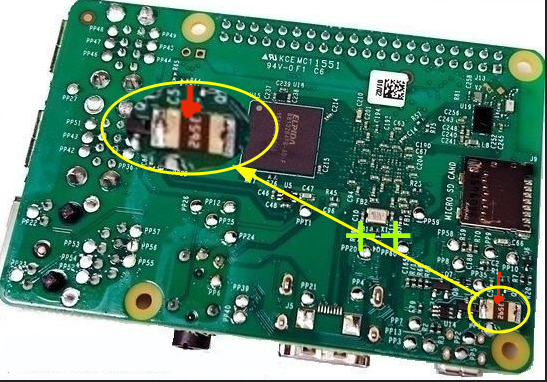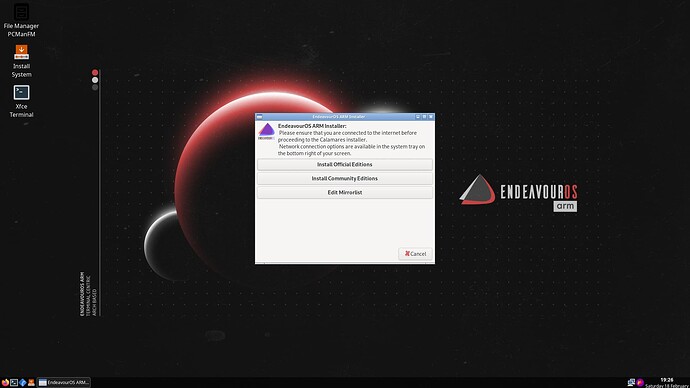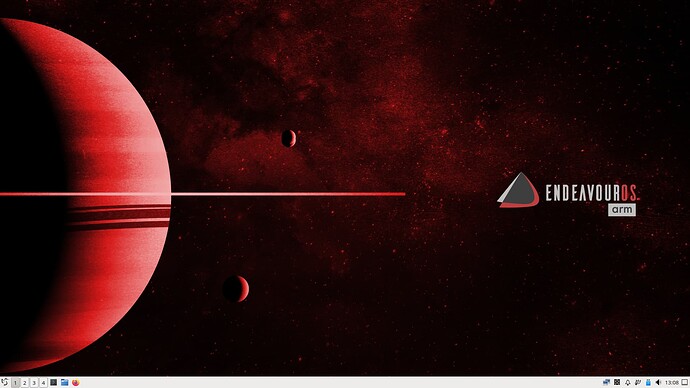I just installed the Arm image on my SSD from EndeavourOS then hooked it up to my Pi 400 and ran the installer. No issues with the installer. Of course for the Pi 400 with the external SSD hardware I’m using which by i mean the enclosure require me to edit the commandline.txt and add a quirk for the usb storage device in order for it to boot. I suggest you run boot on Pi OS and make sure the firmware and bootloader is updated on the Pi then set it to boot from SSD and try the EndeavourOS Arm installer.
Well I tried everything as I mentioned. Flashing from Artemis following guide, on both an SSD and an SD card, then when that didn’t work I used the script method on both… To no avail always boots to desktop with nothing working double clicking on all icons does nothing… Seems to me like permission issue… As to why it’s happening it’s beyond me…
Am at a loss just wanted to test EOS for fun I have no use for Pi either way it’s a useless device for me… Thank you all for trying to help…
Just for grins and giggles, maybe you could take a look at this:
and see if this stripped down version works for you. Plus it makes a nice NAS if you don’t already have one.
Pudge
Nahh am not into that stuff… I have a whole desktop PC with over 200TB of storage for my stuff… I also have an HTPC with Manjaro + Plex Server… Am good on all fronts have total of 5 soon 6 Desktops… Pi4 useless… Maybe one day PiHole who knows… Right now letting it catch all the dust in my office…
Hi there…
Any other suggestions for the above problem? My Raspi4 boots up to the desktop, connects via WiFi, and then nothing happens. No icon/button shows a reaction.
Hello, sorry for the problems.
How much RAM does your RPi 4b have ? 4 GB and 8 GB work fine, 2 GB is problematic, and 1 GB is a no go.
Can you enter Ctrl-Alt-F3 and bring up a TTY Console window?
If so, log in and install rpi-eeprom
sudo pacman -S rpi-eeprom
sudo rpi-eeprom-update
*** UPDATE AVAILABLE ***
BOOTLOADER: update available
CURRENT: Tue Apr 26 10:24:28 AM UTC 2022 (1650968668)
LATEST: Wed Jan 11 05:40:52 PM UTC 2023 (1673458852)
RELEASE: critical (/lib/firmware/raspberrypi/bootloader/critical)
VL805_FW: Using bootloader EEPROM
VL805: up to date
CURRENT: 000138a1
LATEST: 000138a1
It seems my RPi 4b has a BOOTLOADER update
If you care to update the EEPROM, which I did
sudo rpi-eeprom-update -a
[sudo] password for don:
*** INSTALLING EEPROM UPDATES ***
BOOTLOADER: update available
CURRENT: Tue Apr 26 10:24:28 AM UTC 2022 (1650968668)
LATEST: Wed Jan 11 05:40:52 PM UTC 2023 (1673458852)
RELEASE: critical (/lib/firmware/raspberrypi/bootloader/critical)
VL805_FW: Using bootloader EEPROM
VL805: up to date
CURRENT: 000138a1
LATEST: 000138a1
CURRENT: Tue Apr 26 10:24:28 AM UTC 2022 (1650968668)
UPDATE: Wed Jan 11 05:40:52 PM UTC 2023 (1673458852)
BOOTFS: /boot
Using recovery.bin for EEPROM update
EEPROM updates pending. Please reboot to apply the update.
To cancel a pending update run "sudo rpi-eeprom-update -r".
Then reboot. This reboot takes a little time as it is upating the EEPROM before rebooting.
Also, go to
https://arm.endeavouros.com/endeavouros-arm-install/
and tell me which method you used to install EnOS ARM. Method 1, 2, or 3.
Method 2 is the easiest.
Simply download an image, and then burn it to a micro SD card, at least 32 GB or larger for best results.
Connect the uSD card to your RPi 4b and it should automatically boot into OpenBox with Calamares running to set up your options.
Pudge
Hi
My Raspi has 8 GB ram. Should i run these command on the EOS installer image??
install rpi-eeprom
Some kind of missing dest.file operand. (sorry, no ssh available to c&p on that stage)
sudo rpi-eeprom-update
command not found…
Next i try to do this on a running raspian… wait for it… ![]()
@RudiOnTheAir
Not sure why you are having problems. There are three different methods to install EnOS Arm. If you do happen to boot it and run on raspberry PiOS you can update the bootloader and eeprom from there. My only suggestion is to then try again as there should be no issue. I am running the Pi400.
Hi
I tried it first with the Live ISO and the script from the welcome “screen”. Then I wrote the image to the SD card with Balena Etcher. Both times the same result. I have a desktop, I can set WLAN and see some right click funktions, but that’s all I can do. No terminal opening from the desktop.
After writing the SD, the window for selecting the install method appears one time. After another start, the system has noted the WLAN settings, but then the install window no longer appears.
BTW. The bootloader update has worked on the raspian sd…
pi@hampi:~ $ sudo rpi-eeprom-update
[sudo] password for pi:
BOOTLOADER: up to date
CURRENT: Wed 11 Jan 2023 05:40:52 PM UTC (1673458852)
LATEST: Wed 11 Jan 2023 05:40:52 PM UTC (1673458852)
RELEASE: default (/lib/firmware/raspberrypi/bootloader/default)
Use raspi-config to change the release.
VL805_FW: Using bootloader EEPROM
VL805: up to date
CURRENT: 000138c0
LATEST: 000138c0
But that changed nothing regarding the installerfunction of EOS…
What site did you download the ISO? I would suggest updating the mirrors and download a new ISO and create another live usb. Maybe pick a different mirror to download the ISO from. I’ve had a few people have bad ISO downloaded from some locations. ![]()
New iso??
The Iso that i have used to install my x86 desktop??
I made the last attempts with the Raspi image from here…
https://github.com/endeavouros-arm/images/releases/tag/rootfs-rpi-20230128
Method 1 and 2 had the same result. It’s probably not because of the Live ISO, imho…
Sorry, my quotes covered more than I intended. ‘install rpi-eeprom’ was not intended to be in the quote field, and it was meant as a generic statement to install rpi-eeprom.
On hind sight, that was quite confusing.
In Archlinux ARM, every install is done through either pacman or yay. So the proper syntax would be
sudo pacman -S rpi-eeprom
Then run the command as ‘sudo rpi-eeprom-update’
Sorry for the confusion. I have corrected the mistakes in Post # 26
Pudge
OK, no problem. But it seems i’ve done the update on a 2nd SD with raspian. But that does not solve the problem…
Running rpi-eeprom updates the physical eeprom chip on the RPi motherboard. Once it is done, no need to run it again until another eeprom update comes along.
rpi-eeprom doesn’t change anything on the micro SD card, so we good there.
If you are using Method 1, then I am not sure what is going wrong. Some things have changed with Arch, let me do some test installs and I will try to find what is amiss.
Back later.
Pudge
EDIT:

Excuse the poor quality of the red arrow. @joekamprad is the master of arrows, I stand in his shadow.
I THINK this is the EEPROM chip. Don’t quote me on that.
Pudge
Ok, thanks for your help.
Btw. My favorite way to put operating systems on SD cards is using the software “balena etcher”.
That may be the problem. Balena etcher can cause problems with Arch Linux.
Let me do some testing and if everything works for me, maybe you can use another etcher.
On your x86_64 machine, what Desktop Environment are you using.
I have used gnome-disk-utility for years and it works perfectly.
@ricklinux prefers popsicle. Actually, rick has dealt with more etcher problems that I have on the forum. Rick, do you still like popsicle?
Back later.
Pudge
I only try to step into the legacy of @fernandomaroto using flameshot

My fav. desktop is xfce4. Maybe it’s balena. But why it gets the same result like running the x86 live ISO and creating the content direct to the sd card…?
I did a test install using Method 1. I used the latest liveISO, Cassini Neo, booted on my AMD Ryzen x86_64 computer.
In the welcome screen , I chose “Start ARM installer” and answered the questions.
I chose ext4 for the filesystem. Then entered the target device for the micro SD card.
When finished, I did not select the “Reboot now” box, and clicked “Done”. then shutdown the x86_64 computer and unplugged the liveISO thumb drive and the micro SD adapter.
Then with out doing anything else, no need for burning a SD, I just connected the micro SD into the RPi 4b uSD connector and booted up. Once the liveISO install is complete, the micro SD is fully installed and ready to boot up in the RPi. No need for balena or any other imager.
After the RPi 4b booted, I got this OpenBox screen, with the modified Welcome screen.
Next thing is to Edit Mirrorlist
More on that once we get a completed install.
Then click for either the EnOS supported Desktop Environment / i3wm you desire, OR click on a Community Edition.
Then a modified Calamares is launched which is quite similar to the x86_64 Calamares.
Next, simply because it is time to re-check the installs, I will test Method 2 and Method 3. These two methods might be a balena problem.
Pudge
Hope this helps.
EDIT:
I am typing this post from the OpenBox window.
EDIT2:
The untouched LXQT desktop just installed.
That was my first try to do the install. And i got the installer window too. But no reaktion on the buttons. The same like the balena way…

